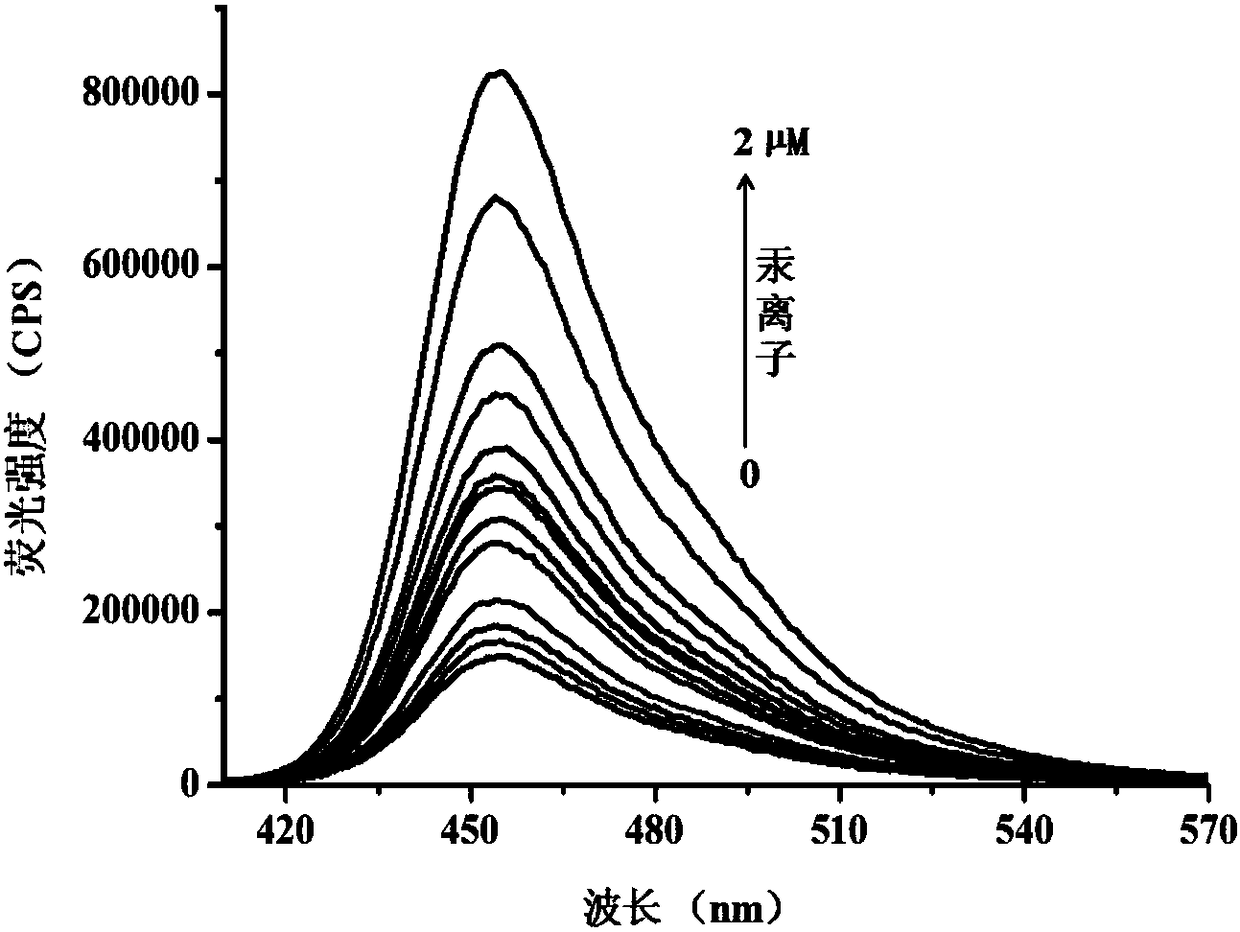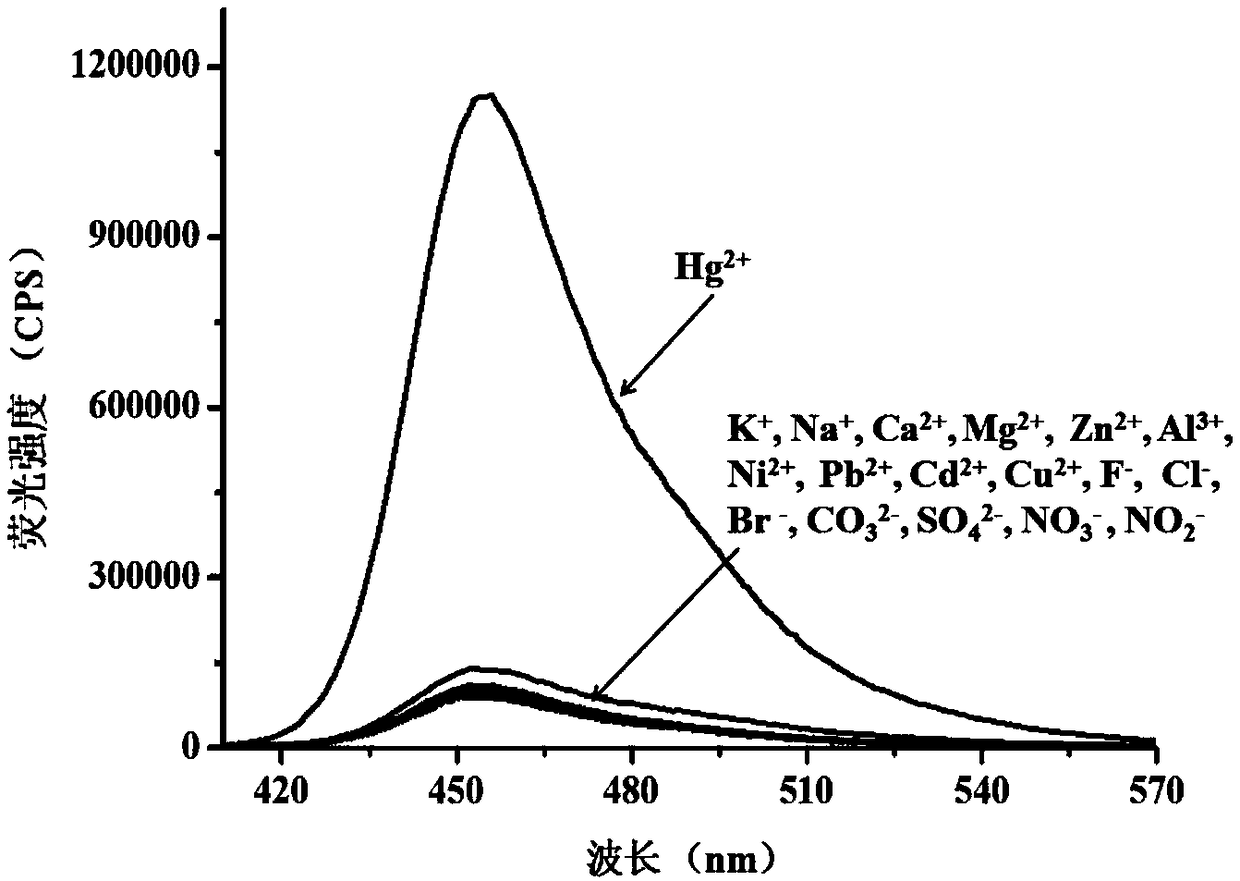Two-photon fluorescence probe for highly selectively and sensitively detecting mercury
A technology of hydrogen atoms and compounds, applied in the field of two-photon fluorescent probes for highly selective and sensitive detection of mercury, can solve the problems of insufficient response speed, complex synthesis, and insufficient selectivity, and achieve high sensitivity, simple synthesis, and stability good sex effect
- Summary
- Abstract
- Description
- Claims
- Application Information
AI Technical Summary
Problems solved by technology
Method used
Image
Examples
Embodiment 1
[0029]
[0030] Dissolve 300mg (1.47mmol) of 7-hydroxy-3-acetylcoumarin in 15mL of dichloromethane, then add 635mg (3.68mmol) of phenyl thiochloroformate and stir for 4 hours at room temperature, then use a rotary evaporator for rotary evaporation. A crude product is obtained. If a purer product is to be obtained, it can be passed through a column and then recrystallized in a mixed system of dichloromethane and petroleum ether (for example, v / v, 1:10) to obtain a pure product. 231mg of white pure product was obtained, the yield was 46%.
[0031] 1 H NMR verified the correctness of the product structure.
Embodiment 2
[0033] Figure 1a are different concentrations of Hg 2+ (0, 0.05, 0.1, 0.2, 0.3, 0.4, 0.5, 0.6, 0.7, 0.8, 1, 1.5, 2μM) on the fluorescence spectrum of the probe (5μM); Figure 1b are different concentrations of Hg 2+ (0-2μM) vs. probe (5μM) fluorescence intensity and the linear relationship between the concentration.
[0034] It can be seen that the fluorescence changes before and after adding mercury ions are very obvious. Hg in the probe solution 2+ As the concentration increases, the fluorescence intensity gradually increases, and at (0-2μM)Hg 2+ Concentration range, Hg 2+ The concentration has a good linear relationship with the fluorescence intensity. It shows that the probe has a good response to mercury ions, and the probe can realize sensitive recognition of mercury ions. The standard limit of mercury ions in my country's drinking water standards is 0.001 mg / L. Therefore, the probe of the present invention can more accurately determine the content of mercury ions...
Embodiment 3
[0036] Figure 2a is the effect of mercury ions (5μM) and other different ion analytes (25μM) on the fluorescence spectrum of the probe (5μM). Figure 2b is the influence of other different ion analytes (25μM) on the fluorescence intensity of mercury ion (5μM) and probe (5μM) at 455nm wavelength respectively.
[0037]Analytes include: 1. Mercury ions, 2. Potassium ions, 3. Sodium ions, 4. Calcium ions, 5. Magnesium ions, 6. Zinc ions, 7. Aluminum ions, 8. Nickel ions, 9. Lead ions, 10 .Cadmium ion, 11. Copper ion, 12. Fluoride ion, 13. Chloride ion, 14. Bromide ion, 15. Carbonate ion, 16. Sulfate ion, 17. Nitrate ion, 18. Nitrite ion, except The concentration of mercury ions is 5 μM, and the concentration of other analyzed ions is 25 μM. All test conditions were completed in pure water, the probe used was the probe prepared in Example 1, and all spectra were measured at 25°C 60 minutes after the analyte was added. Specifically, pipette 50 μL of 1 mM probe stock solution int...
PUM
 Login to View More
Login to View More Abstract
Description
Claims
Application Information
 Login to View More
Login to View More - R&D
- Intellectual Property
- Life Sciences
- Materials
- Tech Scout
- Unparalleled Data Quality
- Higher Quality Content
- 60% Fewer Hallucinations
Browse by: Latest US Patents, China's latest patents, Technical Efficacy Thesaurus, Application Domain, Technology Topic, Popular Technical Reports.
© 2025 PatSnap. All rights reserved.Legal|Privacy policy|Modern Slavery Act Transparency Statement|Sitemap|About US| Contact US: help@patsnap.com



